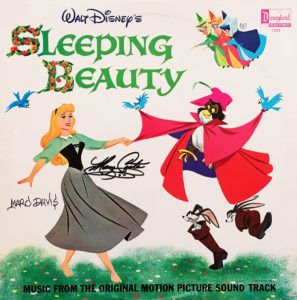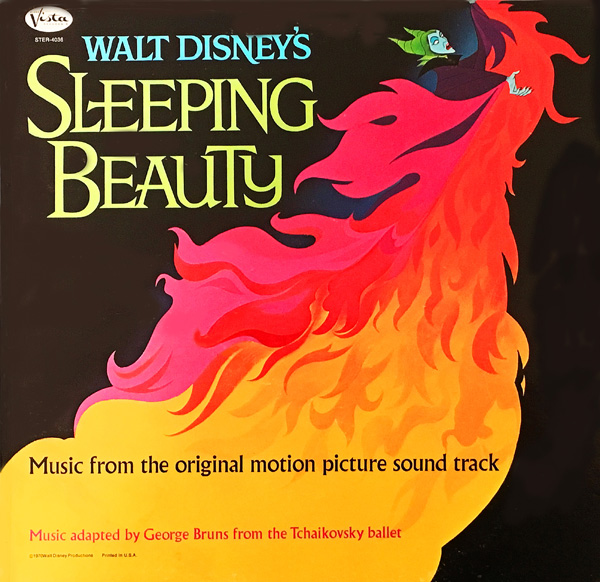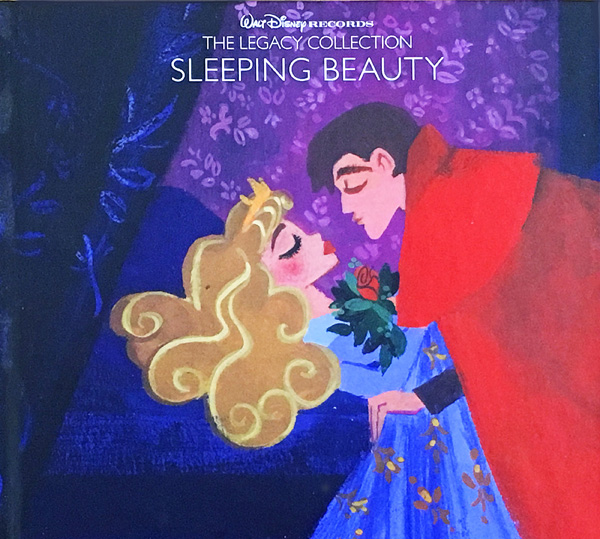The release of the first two-channel stereo sound track for an animated feature was presented with almost as much fanfare as the birth of Princess Aurora herself.

Walt Disney’s SLEEPING BEAUTY
Music from the Original Motion Picture Sound Track
Adapted by George Bruns from the Tchaikovsky Ballet
Disneyland Records STER-4018 (Stereo) WDL-4018 (Mono) (12” 33 1/3 RPM)
LP Reissues:
Disneyland Records DQ-1228 Two Mono Editions: 6/22/62 (Darlene Gillespie); 1964 (Sound Track)
Buena Vista STER-4036 (Stereo / 1970)
Walt Disney Records Picture Disc D002180101 (Stereo / 2016)
Released on January 5, 1959. Executive Producer: Jimmy Johnson. Producers: George Bruns, Tutti Camarata. Musical Direction: George Bruns, Camarata. Running Time: 37 minutes.
Performers: Mary Costa (Aurora/Briar Rose); Bill Lee (Prince Philip); Bill Thompson (King Hubert); Taylor Holmes (King Stefan).
Songs: “Once Upon a Dream” (Main Title) by Jack Lawrence, Sammy Fain; “Hail to the Princess Aurora,” “The Gifts of Beauty and Song,” “True Love Conquers All,” “Sleeping Beauty Song” by Tom Adair, George Bruns; Blue Bird / I Wonder” by Winston Hibler, George Bruns, Ted Sears; “Skumps” by Tom Adair, Ed Penner, George Bruns.
Instrumentals: “Maleficent Appears,” “Woodland Symphony,” “Maleficent’s Evil Spell*,” “Fairies to the Rescue*,” “Bacchanal*,” “The Prince Dreams of Sleeping Beauty*,” “Battle with the Forces of Evil,” “Awakening” by George Bruns; “The Three Good Fairies (Sing a Smiling Song)” by George Bruns, Tom Adair.
(*These selections are not included on the 1964 edition of DQ-1228.)
 Just before Disneyland Records rebranded itself as a purely children’s label–with Buena Vista Records established as a label for teens, adults and miscellaneous releases (see last week’s Spin on Goofy’s Dance Party )–the label was still the catch-all for the entire line of Sleeping Beauty records.
Just before Disneyland Records rebranded itself as a purely children’s label–with Buena Vista Records established as a label for teens, adults and miscellaneous releases (see last week’s Spin on Goofy’s Dance Party )–the label was still the catch-all for the entire line of Sleeping Beauty records.
It was the most ambitious collection of products the label had ever tackled. In conjunction with Golden Records, which was still releasing 78 and 45 RPM singles produced by Disney, the total of Sleeping Beauty records added up to fourteen separate releases. Ultimately, the enterprise ended up being a test run for the much larger—and more profitable—line of Mary Poppins records.
The entire musical score of Sleeping Beauty was recorded in Berlin, Germany, very likely by the Symphonie Orchester Graunke, most likely conducted by composer George Bruns. Under the baton of Kurt Graunke, this orchestra performed on numerous Disneyland record albums, as well as for the Walt Disney’s Grand Canyon featurette. Released with Sleeping Beauty, this rarely-celebrated, Oscar-winning gem is a like a live-action Fantasia segment, in which narration-free nature footage accompanies Ferde Grofe’s “Grand Canyon Suite”.
Tutti Camarata’s lengthy experience with European musicians and recording facilities must have had a great deal to do with Graunke’s involvement, and also with the resulting quality of the Sleeping Beauty sound track. As Jimmy Johnson noted in the album notes, Camarata “monitored in the control room” during the sessions in Berlin. The music itself was the George Bruns’ Oscar-nominated triumph to be sure, but it’s worth mentioning Camarata’s contributions as they have been more obscured by the various changes in studio staff over the years, fewer accounts of his accomplishments and his own low-key nature.
 he resulting 1959 Sleeping Beauty sound track album, with the scene of Aurora “dreaming of true love in slumber repose” on the front cover, was the resulting release. It was not only the first two-channel stereo sound track for a Disney film in the Disneyland catalog, it was the first such album for any animated feature film (though Mister Magoo’s 1001 Arabian Nights would soon follow). The Fantasia sound track record album had been released in stereo the previous year, but Fantasound was a very different system, designed for playback in theaters with as many as nine channels. Fantasia was a remixed to adapt for two channel stereo records, while Sleeping Beauty was recorded specifically in two channels for home listening as well as theaters.
he resulting 1959 Sleeping Beauty sound track album, with the scene of Aurora “dreaming of true love in slumber repose” on the front cover, was the resulting release. It was not only the first two-channel stereo sound track for a Disney film in the Disneyland catalog, it was the first such album for any animated feature film (though Mister Magoo’s 1001 Arabian Nights would soon follow). The Fantasia sound track record album had been released in stereo the previous year, but Fantasound was a very different system, designed for playback in theaters with as many as nine channels. Fantasia was a remixed to adapt for two channel stereo records, while Sleeping Beauty was recorded specifically in two channels for home listening as well as theaters.
Two of Disney’s other Sleeping Beauty LP releases were covered in earlier Spins: the Official Mickey Mouse Club Records version of the score featuring Darlene Gillespie (soloist on the greatest record ever made) and the Storyteller album told and sung by Mary Martin. 1n 1962, the Gillespie version was reissued on Disneyland with cover depicting Aurora dancing with the forest animals playing her “dream prince.” In 1964, a shortened version of the sound track was issued with the same front cover, except that it specified “original motion picture sound track.”

In 1970, the Walt Disney Studios made the interesting move of focusing on Maleficent in the marketing of the Sleeping Beauty theatrical reissue, de-emphasizing the romance and amping up the action and magic. This concept extended to Buena Vista’s stereo-only reissue of the sound track LP, which sold until the mid-‘70s.

It wasn’t until 2015 that the original 1959 stereo album was issued on picture disc, just as it was heard when first released. This is one of the rare instances in which Walt Disney Records did not simply repurpose the CD material for the picture disc, but instead restored the Disneyland album (thank you, Randy Thornton!).

“Once Upon a Dream” – Mary Costa and Bill Lee
The vinyl sound track album contains a few alternate versions that do not match the film exactly. In the case of “Bluebird/I Wonder,” it offers a longer performance of the song. With “Once Upon a Dream,” we actually hear a different singer in the duet with Mary Costa and a slightly different arrangement. There is no current explanation for this; they could have been recorded before changes were made in the film, or they may have been made especially for the album. We talked about Bill Lee in this Spin.

Walt Disney’s SLEEPING BEAUTY
Special Promotional Record (For Radio Stations Only)
Excerpts from the Sound Track and Popular VersionsDisneyland Records WDL-4018 (12” 33 1/3 LP / Mono)
Released on January 5, 1959. Executive Producer: Jimmy Johnson. Producer: Tutti Camarata. Musical Direction: George Bruns, Camarata. Running Time: 21 minutes.
Jimmy Johnson launched a huge promotional campaign for the various recordings of the Sleeping Beauty score. In addition to sheet music through the Walt Disney Music Company and the sound track album, the label was releasing pop versions of the songs—what is considered “traditional pop” today.
To get the Sleeping Beauty music on radio stations, he released an album with the same front cover as the soundtrack, only there was a small overprint in silver lettering indicating that it was “special.”

The back cover (above) was completely different from the soundtrack release, detailing the merchandising and promotional plans for Sleeping Beauty. “This is a big picture in more ways than one,” say the liner notes, presumably by Disneyland Records President Jimmy Johnson. “It is truly the ultimate in the art of animation, which Walt Disney has made famous.” (If that line sounds familiar to readers of Bob Thomas’ Walt Disney: The Art of Animation, it was Johnson was also responsible, start to finish, for the project of producing the landmark book, which functioned as a love letter to Sleeping Beauty.)
The Commanders, a big band/vocal group that Camarata knew from their work with his friend Louis Armstrong, do a Ray Conniff-type jazz vocal “dah-tah-dah” riff on their songs. One of their tunes is “Sing a Smiling Song,” which is used without lyrics in the film as an instrumental when the three good fairies prepare for Briar Rose’s birthday. Another Camarata collaborator, Claire Hogan, sang with the Jimmy Dorsey Orchestra, for which Camarata was an arranger.
Sound Track Music:
Mary Costa: “Blue Bird / I Wonder,” “Once Upon a Dream”
Disney Studio Orchestra & Chorus: Main and End Titles (“Once Upon a Dream”)
Popular Versions:
Camarata Chorus and Orchestra: Sleeping Beauty Overture, “Love Theme.”
The Commanders: “Sing a Smiling Song,” “Once Upon a Dream.”
Claire Hogan: “I Wonder.”
“Sleeping Beauty Overture” – Camarata Orchestra and Chorus
Disneyland and Buena Vista Records made frequent use of this medley. In addition to being released as a single, it appeared on side two of The Parent Trap score album (available on iTunes) and on a Camarata LP called 33 Great Walt Disney Melodies.

Walt Disney Records’ The Legacy Collection
SLEEPING BEAUTY
Walt Disney Records D-002055092 Two Compact Discs (Stereo)
Released on October 7, 2014. Digital Restoration Producer: Randy Thornton. Digital Restoration: John Polito. Additional Restoration and Mastering: Jeff Sheridan. Creative Art Direction: Dave Snow, Steve Gerdes. Package Design: Steve Gerdes. Original Paintings and Illustrations: Lorelay Bové. Running Time: 37 minutes.
Performers: Mary Costa (Aurora/Briar Rose); Bill Shirley (Prince Philip); Bill Thompson (King Hubert); Taylor Holmes (King Stefan).
Songs: “Once Upon a Dream” (Main Title) by Jack Lawrence, Sammy Fain; “Hail to the Princess Aurora,” “The Gifts of Beauty and Song,” “True Love Conquers All,” “Sleeping Beauty Song” by Tom Adair, George Bruns; Blue Bird / I Wonder” by Winston Hibler, George Bruns, Ted Sears; “Skumps (Drinking Song)” by Tom Adair, Ed Penner, George Bruns.
Instrumentals: “Prologue,” “Maleficent Appears,” “The Burning of the Spinning Wheels,” “The Fairies,” “Maleficent’s Frustration,” “A Cottage in the Woods,” “Do You Hear That?” “An Unusual Prince,” “A Secret Revealed,” “The Royal Argument,” “Prince Philip Arrives,” “I Know How to Tell Stefan,” “Aurora’s Return,” “Maleficent’s Evil Spell,” “Poor Aurora,” “Forbidden Mountain,” “A Fairy Tale Comes True,” “Battle with the Forces of Evil,” “Awakening” by George Bruns; “Magical House Cleaning / Blue or Pink (Sing a Smiling Song)” by George Bruns, Tom Adair.
Bonus Tracks: Camarata Chorus and Orchestra: Sleeping Beauty Overture, “Love Theme.”
Mary Costa: “Blue Bird / I Wonder” (Alternate Version)
Mary Costa and Bill Lee: “Woodland Symphony / Once Upon a Dream” (Alternate Version)
Lost Chords: See this previous Animation Spin for details.
Randy Thornton had produced two sound track CD releases for Sleeping Beauty with all the music from the film before, but this lavish “Legacy Collection” set puts all of that material together in one package, plus the Lost Chords and the four selections previously heard only on the 1959 vinyl album.
It’s contained in a hardbound book with new art by Lorelay Bové, rare art and notes by Thornton, Disney historian Paula Sigman-Lowery and the original Lost Chords archivist Russell Schroeder. All that is missing is the bow to tie it up all nice.
“Once Upon a Dream” – Mary Costa and Bill Shirley
A different vocal and arrangement, as heard in the final film. Bill Shirley, by the way, sang off screen for Jeremy Brett in My Fair Lady and played Stephen Foster on screen in 1952’s I Dream of Jeanie (not to be confused with the classic TV sitcom).


 GREG EHRBAR is a freelance writer/producer for television, advertising, books, theme parks and stage. Greg has worked on content for such studios as Disney, Warner and Universal, with some of Hollywood’s biggest stars. His numerous books include Mouse Tracks: The Story of Walt Disney Records (with Tim Hollis). Visit
GREG EHRBAR is a freelance writer/producer for television, advertising, books, theme parks and stage. Greg has worked on content for such studios as Disney, Warner and Universal, with some of Hollywood’s biggest stars. His numerous books include Mouse Tracks: The Story of Walt Disney Records (with Tim Hollis). Visit 





















































Mary Costa has a killer autograph! 😀
Yes, her script is gorgeous. Unfortunately a few years ago she finally had to stop signing…she is 88 on April 5. I am lucky to have met her twice.
In the old “tour of Disneyland” record (instrumentals with Walt’s spoken introductions), the Fantasyland carousel plays old non-Disney music, but a more recent CD has “Once Upon a Dream”. If that’s what’s playing now, when did they switch it in?
My guess would be that the music changed in 1983 when Fantasyland had a major renovation.
There was an album released under the Mickey Mouse Club Records label that featured the story and music from Sleeping Beauty. The color cover had a magnificent background of the castle with the characters posing on the castle steps. Even Maleficent posed with her raven, although at a slight distance from the others. The record had six songs on it. On the first side, the songs included narration by Darlene, but on the second side the songs continued roughly in the same order as in the movie, but without any narration. So the story stopped after Briar Rose’s encounter with the dream prince. Darlene also sang the part of Briar Rose. An orchestra and chorus covered the choral songs and the instrumentals, while a female trio sang “Sing a Smiling Song” and two male singers sang “Skumps.” The final song on the album was a choral arrangement of the Sleeping Beauty song, beautifully performed.
I don’t know when this was released, but it had to have been while the Mickey Mouse Club was still airing–I inherited many records as a child, mostly from my cousin who was four years older. I enjoyed listening to it, except that I could never understand why the story stopped halfway through.
Many years later, I acquired the Mary Martin storyteller version (long after it was probably out of print). This one seems to include the same orchestra and choral renditions as the Darlene version, but Mary sings for Briar Rose. The album also includes the good fairies singing “Sing a Smiling Song” as well as the two kings singing “Skumps” and the recordings sound identical to those on the Mickey Mouse Club album. It seems to have the same choral rendition of “Sleeping Beauty” as well.
It’s too bad in the movie that “Sing a Smiling Song” never quite materializes as a full-blown song. That sequence where the fairies use their magic seems to me to cry out for it. As it stands, the scene where Fauna attempts to sing a few notes in the midst of the magic-making seems rather pointless, since there actually is no song going on. It would have added some more lightness to a film that is overall a bit darker than most Disney features. (Of course, “Snow White” and “Pinocchio” had their share of darkness, too. I’m not saying that’s a bad thing.) It’s one of the lesser known Disney songs that deserves more attention than it gets.
Thanks for posting on these musical treasures.
Hello, I can not watch the videos and this warning appears: The person who uploaded this video did not allow it to be available in your country.
So why is “Sing a Smiling Song” not on the Legacy collection? You’d think if they were doing such a special set that they would put everything related to the movie in it, wouldn’t you?
Hello. Great post! Do you know who drew the cover of the WDL-4018 album? It is gorgeous! I think the artist’s signature is just under the word ADAPTED on the cover. I thought it might be Paul Wenzel, but the signature looks different. Thank you.
I’ve wondered that too. All I know, is that the Aurora/”Sleeping Beauty” painting was also used on some promotional material for the original 1959 release of the film such as a lobby card and the film’s original theatrical poster (the poster didn’t use the whole painting, just a clipping of Aurora)
The original soundtrack of Sleeping Beauty in the theaters was in 6 channel stereo in the 70mm Super Technirama 70 version, and in 4 channels in the 35mm ordinary Technirama version, NOT 2 channel, as it says in the article, so, the following claim is incorrect, “Sleeping Beauty was recorded specifically in two channels for home listening as well as theaters.” NO! It was even mixed down to 3 channels for the 1959 TV preview (tacked on to The Peter Tchaikovsky Story), on the Disney show, and viewers had the option of hearing it in three channels, with the Left channel broadcast on FM radio, the Center channel on TV, and the Right channel on AM radio. Walt explained to viewers how to hook it up.
Apparently, the MUSIC was recorded in 4 channels and expanded to 6 for 70mm, a common practice then for many films, including Lawrence of Arabia.
I have most of the albums and some of the singles from ”Sleeping Beauty”. A British label, ”Top Rank” (affiliated with the J. Arthur Rank film company) released the soundtrack with a similar (almost as stunning) cover to the U.S release. As far as I can tell, the album was available in mono only. This one is harder to track down, but I got one a few years ago. Despite the lack of stereo sound, it’s still crisp and clear, and actually has some dimension. It’s one of my favorites in the collection.
Look what I found on Facebook: https://www.facebook.com/score.man.9/videos/193637564077154/? I thought that the full version of this soundtrack existed from Disney Records, but this exceeds all my expectations. This is amazing…….OMG 🤩 !!!!
Does anyone have any info on the cancelled mid-90s reissue of the film? I saw it advertised but it never actually came.